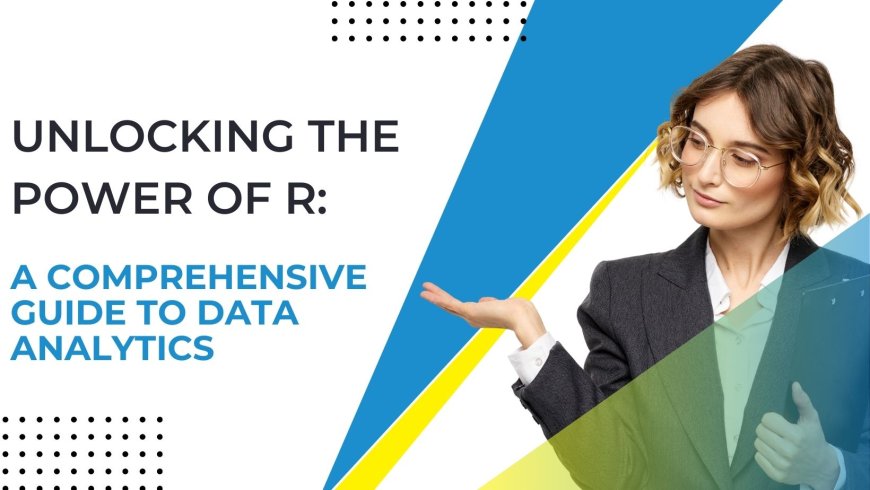Unlocking the Power of R: A Comprehensive Guide to Data Analytics
This article introduces R, a powerful programming language for statistical computing and data visualization in data analytics. It explores R's key features, its role in the analytics workflow, and provides guidance on getting started with practical techniques. Perfect for beginners and those looking to enhance their skills, this guide equips readers to effectively harness R for data analysis.

Data analytics has become a cornerstone for decision-making across industries. Among the many tools and languages available, R stands out as one of the most powerful for data analytics due to its open-source nature, wide range of packages, and robust statistical capabilities. Whether you are a beginner or a seasoned professional, understanding R is a crucial step in mastering data analytics.
In this article, we will explore what R is, why it is important in data analytics, the benefits it offers, and how you can begin using it effectively.
What is R?
R is a programming language and software environment primarily designed for statistical computing and data visualization. It was created by statisticians and is widely used by data analysts, researchers, and professionals across multiple fields. The language is open-source, meaning it is freely available to anyone who wishes to use it, with a large community constantly contributing to its development.
Key Features of R
-
Statistical computing: R is designed for data manipulation, statistical modeling, and testing, making it ideal for analytics.
-
Data visualization: R provides powerful tools for visualizing data, including popular libraries like ggplot2 and plotly.
-
Extensibility: R's package ecosystem makes it easy to extend its functionality, allowing you to handle diverse data analytics tasks.
Why R is Popular in Data Analytics
The adoption of R in the data analytics world is driven by its flexibility and ability to handle complex statistical operations. Here are some reasons why R has gained popularity in this domain:
1. Specialized for Data Analysis and Statistics
Unlike some other programming languages that serve multiple purposes, R was specifically built for statistical analysis. Its core functionalities allow users to perform descriptive statistics, regression analysis, and machine learning effortlessly. R provides an intuitive environment for both simple and complex statistical computations, making it indispensable in data analytics.
2. Data Visualization Capabilities
Data visualization is a key aspect of analytics, as it helps convey complex information in an understandable manner. R excels in this area with packages like ggplot2, which provides a high level of customization for charts, plots, and graphs. This allows analysts to uncover trends, patterns, and insights within data and communicate them effectively.
3. Large Repository of Packages
R’s package repository, CRAN (Comprehensive R Archive Network), offers over 18,000 packages specifically developed for data manipulation, analytics, and visualization. This vast collection enables users to perform highly specialized data tasks such as time series analysis, text mining, and bioinformatics.
4. Strong Community Support
Since R is an open-source language, it has a large, active community that continuously contributes to its development. The R community offers numerous forums, guides, and resources that make it easier for beginners to learn and for experts to find solutions to more complex problems.
How R Fits into the Data Analytics Workflow
Understanding where R fits into the data analytics workflow can help you grasp its value. A typical data analytics project involves several key steps, and R plays a significant role in many of these.
1. Data Collection
R allows analysts to import data from multiple sources, including CSV files, Excel spreadsheets, databases, and even web scraping. Packages like readr and readxl make the data collection process easy and efficient.
2. Data Cleaning and Preprocessing
Data cleaning is crucial, as raw data often comes with missing values, inconsistencies, and outliers. R provides numerous functions to handle these issues, ensuring that the data is prepared for analysis. The dplyr and tidyr packages are popular choices for data manipulation and transformation tasks.
3. Data Exploration and Analysis
Once the data is cleaned, R offers various statistical techniques to explore and analyze it. Techniques like descriptive statistics (mean, median, mode) and inferential statistics (t-tests, ANOVA) can be applied using R's built-in functions. R also supports complex data analysis, including predictive modeling and machine learning algorithms.
4. Data Visualization
As mentioned earlier, R is highly regarded for its data visualization capabilities. Libraries like ggplot2 and plotly help in creating insightful visualizations that aid in the understanding of trends, patterns, and anomalies within the data. The customization options allow users to tailor the visual output to their audience.
5. Reporting and Presentation
R can also help in the final stage of reporting and presentation. With markdown capabilities, users can create dynamic reports combining code, analysis, and visualizations. R Markdown is particularly popular for creating reproducible research documents, ensuring that the entire analysis can be shared transparently.
Advantages of Using R in Data Analytics
Using R in data analytics provides numerous benefits, from statistical precision to community support. Here are some of the major advantages of using R:
1. Versatility and Flexibility
R’s versatility means it can handle a wide range of tasks, from simple data manipulation to complex statistical modeling. Its flexibility allows analysts to solve specific problems in various domains, including finance, healthcare, and marketing.
2. Reproducibility
One of the main challenges in data analytics is ensuring that results are reproducible. R provides tools like R Markdown, which help to document your process and ensure that anyone can reproduce your analysis from the same data and code.
3. Wide Range of Statistical Functions
R provides comprehensive statistical functionalities. It supports both basic statistical operations and advanced methodologies such as generalized linear models, time series analysis, and survival analysis.
4. Robust Community and Resource Availability
The open-source nature of R ensures that there are numerous resources available online. Whether it's tutorials, forums, or comprehensive documentation, the R community offers immense support to both beginners and advanced users alike.
Challenges of Using R in Data Analytics
While R is powerful, it is not without challenges. Some of the common hurdles include:
1. Steep Learning Curve
For beginners, R may have a steep learning curve, especially for those without a background in programming or statistics. It can take time to get comfortable with the syntax and functionality.
2. Memory Consumption
R tends to consume a lot of memory, especially when handling large datasets. This can lead to slower performance if you are working on a computer with limited resources.
3. Limited Scalability
Compared to other programming languages like Python, R may not scale as efficiently when dealing with big data. However, there are workarounds such as integrating R with big data tools like Hadoop and Spark.
Conclusion
R is undoubtedly one of the most valuable tools for data analytics, offering specialized features for statistical computing and data visualization. With its vast library of packages and strong community support, R can help analysts at every stage of their analytics workflow, from data cleaning to reporting. While it comes with some challenges, the advantages far outweigh the drawbacks, making it a must-learn tool for anyone serious about a career in data analytics. For those considering a more structured approach, enrolling in a data analytics course in Noida, Delhi, Meerut, Chandigarh, Pune, and other cities located in India can provide valuable guidance and hands-on experience.
By investing time in learning R, practicing with real datasets, and leveraging its robust packages, you will be well-equipped to take on complex data challenges and extract meaningful insights.
What's Your Reaction?















![Noots Focus Reviews [Truth Exposed 2025]!](https://news.bangboxonline.com/uploads/images/202501/image_430x256_678e3b94881a1.jpg)








